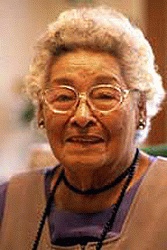|
Ebba Hamm was born November 8, 1911, at Bonanza, a former mining community. When she was 8 years old, she moved with her family to Haycock in Northwest Alaska. Her father ran a trading post and roadhouse. Today, Haycock, also a mining community, is virtually deserted, but in 1920, it had a population of 162. Mrs. Hamm's father, Fred Swanson, was originally from Goteborg, Sweden. Her mother, Jessie Nanouk Swanson, was born in St. Michaels. Mrs. Hamm spent extended periods of time with her grandparents and recalls their traditional lifestyle. She also describes an incident of prejudice she experienced after she moved to Anchorage with her husband, Nolan Hamm. The following narrative was developed through interviews with CIRI Historian Alexandra J. McClanahan.
 |
| Ebba Hamm |
 |
There was never a harsh word with my grandpa and grandma. They were so easy to live with, you might say. I would stay with them for three or four months at a time, sometimes longer. My mother had too many small kids to take care of, and the old folks wanted me along anyway. They were always in isolation. They always caught their fish in a real good stream -- away from the village. They would catch their seal. They never stayed in one spot very long. They just went with the seasons and got all their food. I remember my grandma – she wanted to live in the village, be with other people. And Grandpa would say, "Well, it's too hard to hunt. It's not a very good place to hunt, staying in the village."
They really lived subsistence. It was a good life with them as long as they could hunt and get their own food and everything. But I didn't have anybody to play with when I was with them. It was just me. My grandma would make me rag dolls, and I'd play with the rag doll.
The missionaries named him Peter and her Mary. They had Eskimo names. I called them Apak, which means Grandpa, and Akong, which is what my mother called her.
I left home and came down here to Anchorage. We, Nolan and I, were asked to go to the Idle Hour, a club by Spenard Lake. This couple wanted to take us out. It must have been '42. The husband bought the tickets so we could go into the club. And he said, "Four of us."
"She can't go in." That's what the manager said, the guy taking tickets.
And the husband said, "Why?"
"Well, she's a Native, isn't she?"
He says, "Yes. That's got nothing to do with the ticket."
"Oh, yes, it has. We don't allow Natives or Filipinos in this club."
It was just a dancehall.
He said, "All right, I'm not buying the tickets. We'll go someplace where we're welcome."
So he took us to town. And I never noticed the signs on the buildings before, but I began to notice, "No Natives or Filipinos allowed in this café."
I can't remember the name of the dancehall where we went. Everybody was having a good time, fishermen, the whole works. And the husband couldn't get over that. I didn't think about it too much because I was having a good time. But he was the one that was upset more than I was.
Anyway, the signs had to go down when Fort Rich was built. The general said the military was off limits to Anchorage if that's the kind of a sign they're going to have. So the people had to take the sign off. Besides, there were a lot of Natives in the military, too. They had to take their training out there.
Photo © 1999, Kristen Kemerling
|
 |
|




